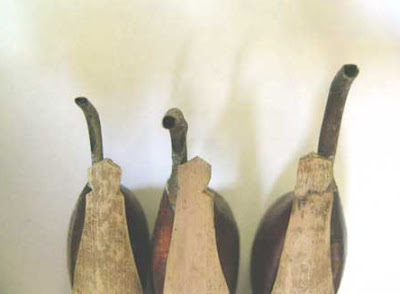Canting Batik is Indonesian traditional tool used to apply wax in fine dots and lines on the fabric. Regardless of where wax is applied, the fabric holding the next dye bath is placed in ... leaving white dots / line (or another color if the fabric is dyed).
 Though the size of most canting are similar .. the difference is in the "tip" that allows the wax to flow from the "bowl". Bigger holes in the tip allow wider lines and bigger dots.
Though the size of most canting are similar .. the difference is in the "tip" that allows the wax to flow from the "bowl". Bigger holes in the tip allow wider lines and bigger dots. Looking down on the top of the "bowl" where the wax is held prior to application to the cloth.
Looking down on the top of the "bowl" where the wax is held prior to application to the cloth. This closeup shows the various sizes of opening holes in the tips.
This closeup shows the various sizes of opening holes in the tips. Each wax dot is applied one by one by the canting.
Each wax dot is applied one by one by the canting. The canting points to the curvy lines which it created in this finished piece of batik.
The canting points to the curvy lines which it created in this finished piece of batik.
The canting points to the small dots it created in this finished piece. [Via]













